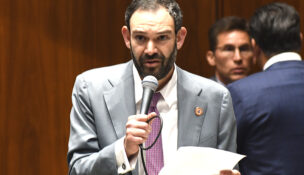Prosector recalls Miranda decision
Arizona Capitol Reports Staff//June 9, 2006//[read_meter]
The confession, in which a suspect in a crime admits to his deeds, was at the heart of the U.S. Supreme Court decision in 1966 that affirmed the right of the accused to remain silent.
Supporters and dissenters alike agree that the decision in Miranda v. Arizona was a watershed ruling in criminal justice. What is less remembered is that Ernesto A. Miranda, one of the men whose cases led to the decision, eventually was convicted a second time on exactly the same charge of which his initial conviction was overturned in the landmark case. And the man who won that conviction, which wasn’t overturned, was Bob Corbin.
Mr. Corbin, at the time of the Miranda decision, which was issued June 13, 1966, was Maricopa County attorney. He later was elected Arizona attorney general. The decision threw out the Miranda’s signed statement that on March 2, 1963, he had kidnapped a young woman off a street in Phoenix, drove her to a deserted area and raped her.
The Supreme Court decision not only threw out Miranda’s confession but also the victim’s subsequent identification of Miranda as the man who had kidnapped and raped her. The accused had not been informed of his right to say nothing to police and hadn’t been informed of his right to have an attorney present during questioning, the high court ruled. And because the illegally obtained confession led to the victim’s subsequent identification of the suspect, that identification, too, was obtained illegally.
“It was the fruit of the poisoned tree,” Mr. Corbin said. Without the confession Miranda had given to Phoenix police detectives and the victim’s identification of the suspect, the prospect of winning a second conviction “didn’t look good at all,” Mr. Corbin said recently in a telephone interview from his home in Prescott.
“Really all I had left was a gal who had been kidnapped,” Mr. Corbin said.
Still, Mr. Corbin said, he was determined to try to make a case against Miranda. Mr. Corbin began to review evidence, including a police report that mentioned a woman Miranda had been living with for some time, Twila Hoffman. From what Mr. Corbin could see, apparently no one had questioned the woman.
“I began wondering whether Miranda had talked about what had happened,” Mr. Corbin said. “I also wondered whether Miranda and this woman were married or not.”
The answer to that question was key. Mr. Corbin knew that in Arizona, conversations between spouses are privileged. The same was true in California, where Miranda and Ms. Hoffman had lived together for some time before moving to Arizona.
“She couldn’t have testified against him if they were married, but they weren’t,” Mr. Corbin. “To this day, I can’t figure out why nobody had ever talked to [Hoffman].”
Mr. Corbin made his case against Miranda based on that contact with Ms. Hoffman. By the time of Miranda’s second trial, in early 1967, Mr. Corbin found Ms. Hoffman willing to talk, as she and Miranda were not getting along.
“I asked her, ‘Did he ever tell you about this?’ and, lo and behold, he had,” Mr. Corbin said. Ms. Hoffman had visited Miranda in jail three days after his arrest and, during that visit, Miranda told her “everything that had happened.”
“With that, we got a conviction,” Mr. Corbin said.
When Miranda was convicted a second time for kidnapping and raping Patricia Doe, Miranda’s attorney John P. Frank filed an appeal with the Arizona Supreme Court. The late Mr. Frank, who previously had successfully argued before the U.S. Supreme Court that Miranda’s confession was obtained illegally, reasoned before the state high court, the second confession made to Ms. Hoffman was no more valid than that given to Phoenix police.
Miranda “still was under arrest, still in prison, still had no counsel and still had no knowledge of his rights,” Mr. Frank stated in his brief. “Every element of which had been involved in the original confession also inherited in its successor.”
The state Supreme Court saw it otherwise.
”We believe it to be conclusively established here that Mrs. Hoffman was in no way acting for the police when she visited the defendant with whom she was living and to whom she referred as ‘husband’ on occasion,” the Arizona Supreme Court ruled.
Miranda remained in prison, where he had been since March 1963 on conviction of an unrelated robbery charge. He was turned down for parole four times but succeeded on the fifth time, leaving prison in December 1972. Miranda went back to prison in mid-1974 on a parole violation, for having a handgun. Released in December 1975, Miranda was stabbed to death in a Phoenix bar on Jan. 31, 1976. He was 34.
“With a lot of crimes, a confession is all you’ve got,” Mr. Corbin said, reflecting on the significance of the Miranda decision. “It came at a time when the criminal justice system was changing. And a lot of criminals did walk because of that [decision].”
One irony of the decision throwing out the confession Miranda had made is that it wasn’t any different than many other confessions Phoenix police had obtained in almost routine fashion for years, said Carroll Cooley, one of two Phoenix police detectives who obtained the now famous confession from Miranda.
“And here’s another one. Miranda made another confession to us in another rape that wasn’t appealed and didn’t get thrown out,” said Mr. Cooley, who still resides in Phoenix. It was that conviction on that crime that had kept Miranda in prison during the course of the appeals that ultimately led to the U.S. Supreme Court decision.
Mr. Corbin said the Miranda decision certainly made prosecutors and police work harder.
“I think it swung too far in favor of suspects,” Mr. Corbin said. Mr. Cooley agreed.
“There’s no way you can even calculate how many criminals this has set free,” Mr. Cooley said.


















